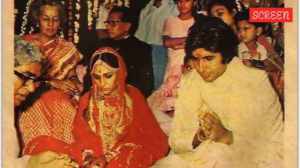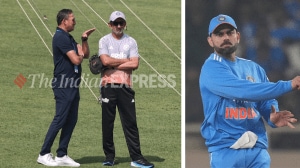Whats your caste?
Independent Indias first caste census took off last week in a small village in Tripura.
When the history of modern Indias engagement with caste is written,will Budhrai Debbarma be remembered?
Here he is,a wiry man in his 60s,from a village in West Tripura district,staring at the camera with a dignity that masks his confusion at the fuss over him. Only yesterday,he had shared the stage set up on the grounds of Sankhola village school with officials who had come from as far as Delhi and Agartala,as an enumerator led him through a list of questions.
They asked me what I do,how much I earn,how many children I have…, he says,trailing off. And also,the contentious question: what is your caste?
He answered without a shrug,or a sense that it was of great import. Amra Tripuri (We are Tripuris), he says in Bengali when we ask him,and then nods on prompting,as if unconvinced: Oy,ST (Scheduled Tribe).
The first man in independent India,the first of 1.2 billion,to be asked by the government to identify himself by his caste.
Strewn around him are the remains of that daythe stage on which he sits is bare of its red carpet,and the pavilion under which villagers had gathered to watch the proceedings reduced to a grid of bamboo poles now holding up just the sky. Budhrai,who has been a daily wage labourer for as long as he can remember living in these lush green plains,seems unsure of the benefits of his moment of glory,his brush with the inscrutable Indian state.
They took pictures,they showed me on TV. But do you think they will help my son find a job?
In September last year,the Union Cabinet announced it would hold a caste census across the country between June and September,2011. The Socioeconomic and Caste Census was launched by the Ministry of Rural Development in Sankhola village in Hezamara block of West Tripura district on June 29.
An estimated 1,500 enumerators have been tasked to reach out and record Tripuras population of 36 lakh.
The last caste census was carried out in India in 1931. After Independence,the first rulers of democratic India refused to make it a marker of identity in the belief that the state would work towards blunting an oppressive caste system.
The UPA governments decision last year to reverse that stance raised many questions. How could a modern republican state endorse a discriminatory system of social stratification that fixes an individuals identity on the basis of her birth? The counter-view: how can the benefits of reservation reach the dispossessed if a caste map is not drawn up and their numbers not ascertained?
In Tripura,a state on the easternmost tip of the country,where the margins of India dissolve with Bangladesh in an endless stream of rivulets,the fractious politics over caste seem as remote as the mainland. The caste system as you know in the rest of the country is not an issue here, says State Rural Development Minister Jitendra Choudhury. For us,what is more important is the socioeconomic survey that will determine the number of BPL households in the state so that welfare schemes can be targeted efficiently.
The population break-up of Hezamara block indicates the different cultural dynamic. The number of STs is 50,021,and SCs 261. The politics of identity plays out here instead in the uneasy relationship between the majority Bengali community and the native tribes.
***
Up a paved path that bleeds often into clots of red earth,past rows of shegun (teak) trees weeping in the rain and curious children peeking from behind bamboo doors,is Satrabari village.
Here,on the edge of this forgotten country,the sarkar has arrivedin the form of enumerator Santosh Taanti and Chiro Debbarma,a young data entry operatorto find and count its poor. As news of their presence spreads,other villagers crowd around to ask them not to skip their houses,though none is aware what they are here for.
At house no. 81,Samhita Debbarma and her children greet them with wary looks. We have come here for the socioeconomic census, says Taanti in Bengali (one of the official languages of Tripura) as Samhita returns a look of incomprehension.
Chairs are brought out,and a bench dusted for the visitors. She nods when Chiro speaks up in the native language,Kakboro. Her mother-in-law Rajmala emerges from the house to gaze wide-eyed at the gathering,and shakes her head vigorously in alarm when I ask and write down her name.
In Chiros hands is a 7-inch Android tablet computer,specially designed by Bharat Electronics for this survey. Each tablet is fed with the data of 100 householdsfamily size,number of members,etccollected in the 2011 Census,as well as the questionnaire for the current census. As Chiro gingerly types in the house number,a pale watery script swims into view: the names of Samhita and Anil,and their four children.
Samhitas answers to the questionsis her house made of mud or brick,does she have a tin roof over her head,does the family own land,is anyone in her family disabled,etcare entered into the blinking machine,and will determine on which side of the poverty line her family will end up. She giggles when asked if there is a fridge in the house. And a mobile? Oh,yes,everyone has a mobile, says Taanti. But she believes that the income from the shop (Rs 5,000 a month) is not enough to make ends meet.
The terms of mapping of the poor have already disappointed the state government. A day after the launch of the census,chief minister Manik Sarkar objected to the Planning Commissions cap on the number of BPL households per state even before the survey has been wrapped up. For instance,the number of BPL households in Tripura cannot exceed 44.5 per cent of its population,even if it means keeping the less poor out. We have already placed our objection before the Planning Commission. This is an arbitrary and unscientific figure and will only end up harming the poor, says minister Choudhury.
At the Sankhola market,though,villagers gathered for evening gossip dont worry about the shrinking of the welfare net,or how the caste census could affect the prospects of their children. Na,caste census ki janina (I dont know what it is about, says Anil Debbarma,Samhitas husband. Does the Scheduled Tribe tag help them? No,none of us got jobs, he says,without any bitterness.
Budhrai Debbarma also unwinds for a long chat,as he reminisces about the old days. When I was a young man,foxes used to roam here. This road you see wasnt there,neither this school. I would earn five rupees for a day of labour. Now NREGA work pays me Rs 118 a day, he says. Things have improved. Aro hoibo. (It will get better).
The device
The $35 tablet PC,unveiled by HRD Minister Kapil Sibal in July last year,is being used for the BPL survey and caste census. Over six lakh of these units loaded with Googles Android 2.2 operating system will be used. The machine will use Java-based user interface software linked to SQLite back-end database to store information that will capture the socio-economic profile of over 200 million households as part of the two surveys
This touch-screen tablet PC will be clubbed with an external keyboard along with a spare battery back-up of 10 hours to work in different situations across the country. A solar cell will charge the spare batteries while operating the device
After filling in the information,the data will be downloaded to a central server. In cases where there is no direct internet link to the central server,the data may be loaded to an intermediate server from where it will be subsequently uploaded to the central server.
The last caste census
The last caste cenus was carried out in pre-Independence India in 1931 by Census Commissioner and anthropologist J H Hutton. Hutton,who later wrote Caste in India (1946),widened the scope of the 1931 Census to include all the tribes and the exterior castes (now called Scheduled Castes)
The 1931 Census enumerated all primitive tribes and arrived at a figure of 24.6 million (including Ceylon and Burma) out of a population of 352 millionthats 6.9 per cent of the total population
The 1931 census prepared a complete list of the exterior castes (SCs) that suffered from social disabilities such as denial of access to temples,schools and wells. The other parameters for inclusion in this category were non-servicing by Brahmins,barbers,water carriers,tailors etc. and pollution by touch and acceptance of water. The 1931 census identified 277 such castes,adding up to a population of 5,01,95,77thats 10.1 per cent of the
total population
- 01
- 02
- 03
- 04
- 05































